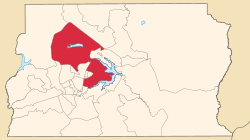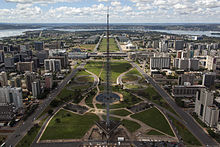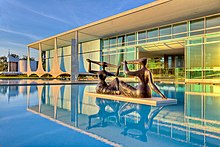برازيليا
برازيليا (Brasilia) (پرتگالي تلفظ: [bɾaziʎɐ]) برازيل جي وفاقي راڄڌاني آهي. هي شهر ملڪ جي مرڪزي-اولهه واري علائقي ۾ برازيل جي بلندين ۾ واقع آهي. اهو 21 اپريل 1960 تي صدر جوسلينو ڪوبٽسچڪ طرفان، نئين قومي راڄڌاني طور ڪم ڪرڻ لاء قائم ڪيو ويو. اندازو آهي ته، برازيليا، ساؤ پولو ۽ ريو ڊي جينيرو کان پوءِ برازيل جو ٽيون سڀ کان وڌيڪ آبادي وارو شهر آھی. وڏن لاطيني آمريڪي شهرن ۾، ان ۾ سڀ کان وڌيڪ جي ڊي پي في ماڻهو آهي.
| برازيليا Brasília | |
|---|---|
| گاديء وارو شھر | |
 | |
| عرفيت: Capital Federal, BSB, Capital da Esperança | |
| نعرو: "Venturis ventis" (Latin) "To the coming winds" | |
 وفاقی ضلع میں براسیلیا مقام | |
| ملک | سانچو:Country data برازیل |
| علاقہ | وسطی مغربی |
| ریاست | |
| قیام | اپریل 21, 1960 |
| پکيڙ | |
| • گاديء وارو شھر | 5,802 ڪ.م2 (2,240.164 ميل2) |
| بلندي | 1,172 ميل (3,845 ft) |
| آبادي (2010) | |
| • گاديء وارو شھر | 2,562,963 |
| قسم | Cultural |
| معيار | i, iv |
| عهدو | 1987 (11th session) |
| حوالا نمبر. | 445 |
| State Party | Brazil |
| Region | Latin America and the Caribbean |
برازيليا هڪ رٿابنديءَ وارو شهر هو، جيڪو سال 1956ع ۾ لوسيو ڪوسٽا، آسڪر نيميئر ۽ جواڪيم ڪارڊوزو طرفان تيار ڪيو ويو، ان منصوبي ۾ راڄڌاني کي ريو ڊي جينيرو کان وڌيڪ مرڪزي مقام ڏانهن منتقل ڪيو ويو. نظارن جو معمار رابرٽو برل مارڪس هو. شهر جي ڊيزائن ان کي انگن اکرن ۾ ۽ گڏوگڏ مخصوص سرگرمين لاءِ شعبن، جهڙوڪ هوٽل سيڪٽر، بئنڪنگ سيڪٽر ۽ ايمبسي سيڪٽر ۾ ورهائي ٿي. برازيليا کي سال 1987ع ۾، ان جي جديد فن تعمير ۽ منفرد فني شهري منصوبابندي جي ڪري، يونيسڪو جي عالمي ورثي واري ماڳ طور شامل ڪيو ويو. ان کي آڪٽوبر 2017ع ۾ يونيسڪو پاران "ڊیزائن جو شهر" جو نالو ڏنو ويو ۽ ان وقت کان وٺي تخليقي شهرن جي نيٽ ورڪ جو حصو آهي.
اهو ان جي سفيد رنگ، جديد فن تعمير لاء قابل ذڪر آهي، جيڪو آسڪر نيميئر پاران ٺهيل آهي. برازيل جي وفاقي حڪومت جون سڀ ٽي شاخون؛ انتظامیا، قانون سازي ۽ عدليه شهر ۾ واقع آهن. برازيليا پڻ 124 پرڏيهي سفارتخانن جي ميزباني ڪري ٿو. شهر جو بين الاقوامي هوائي اڏو ان کي برازيل جي ٻين سڀني وڏن شهرن ۽ ڪجهه بين الاقوامي منزلن سان ڳنڍي ٿو ۽ اهو برازيل ۾ ٽيون مصروف ترين ايئرپورٽ آهي. اهو سال 2014ع فيفا ورلڊ ڪپ جي مکيه ميزبان شهرن مان هڪ هو ۽ سال 2016ع جي سمر اولمپڪس دوران ڪجهه فٽبال ميچن جي ميزباني ڪئي؛ اهو پڻ سال 2013ع فيفا ڪنفيڊريشن ڪپ جي ميزباني ڪئي. هوائي جهاز جي شڪل ۾ رکيل، ان جو "فیوزليج" يادگار محور آهي، وڏين رستن جو هڪ جوڙو هڪ وڏي پارڪ جي ڀرسان آهي. "ڪاڪپٽ" ۾ پراڪا دو تریس پوڈریس (Praça dos Três Poderes) آهي، جنهن جي چوڌاري حڪومت جي 3 شاخن جو نالو رکيو ويو آهي. برازيليا کي هڪ منفرد قانوني حيثيت حاصل آهي، ڇاڪاڻ ته اهو برازيل جي ٻين شهرن وانگر ميونسپلٽي بجاءِ هڪ انتظامي علائقو آهي. نالو "برازيليا" اڪثر ڪري، هڪ مترادف طور تي وفاقي ضلعي جي مجموعي طور تي، استعمال ڪيو ويندو آهي، جيڪو 33 انتظامي علائقن ۾ ورهايل آهي، جن مان هڪ پلانو پیلوتو (Plano Piloto) اصل ۾ رٿيل شهر جو علائقو ۽ ان جي وفاقي حڪومتي عمارتون شامل آهن. برازيليا جي شهر واري علائقي کي ٺاهڻ لاءِ آئ بی جی ای IBGE طرفان سڄو فيڊرل ڊسٽرڪٽ سمجهيو ويندو آهي، ۽ مقامي حڪومت سڄي ضلعي کي سمجهي ٿي ۽ گويا رياست ۾ 12 پاڙيسري ميونسپلٽيز کي پنهنجو ميٽروپوليٽن علائقو سمجهي ٿي.
تاريخ سنواريو
فن تعمیر ۽ شھري منصوبا بندي سنواريو

ٽن طاقتن جي اسڪوائر تي، برازيل جي معمار آسڪر نيميئر ۽ برازيل جي ساختماني انجنيئر جواڪيم ڪاردوزو جديد برازيل جي فن تعمير جي انداز ۾ عمارتون ٺاهيون.[1] ڪانگريس پڻ مختلف ٻين ڀرپاسي عمارتن تي قبضو ڪري ٿو، ڪجهه سرنگن سان ڳنڍيل آهن. نيشنل ڪانگريس جي عمارت ایزو (Eixo) يادگار (شهر جو مکيه رستو) جي وچ ۾ واقع آهي. سامهون هڪ وڏو لان ۽ عڪاسي ڪرڻ وارو تلاءُ آهي. عمارت جي سامهون، پراڪو دو ٹریس پودریس آهي، جتي پیلیسیو دو پلانالتو (Palácio du Planalto) ۽ سپريم فيڊرل ڪورٽ واقع آهن. برازيل جي نظارن جي معمار رابرٽو برل مارڪس ڪجهه پرنسپل عمارتن لاءِ تاريخي ماڊرنسٽ باغن کي ڊزائين ڪيو. رهائشي علائقن ۾، عمارتون تعمير ڪيون ويون آهن جيڪي فرانسيسي ماڊرنسٽ ۽ بوهاؤس ڊيزائن ۾ متاثر ڪيون ويون آهن.[2]
جيتوڻيڪ مڪمل طور تي مڪمل نه ڪيو ويو آهي، "برازيليا يوٽوپيا" زندگي جي نسبتا اعلي معيار جو شهر پيدا ڪيو آهي، جنهن ۾ شهري فطري ماحول واری علائقن ۾ رهندا آهن راندين ۽ تفريحي ڍانچي (سپر ڪوڊرا) جي چوڌاري ننڍن تجارتي علائقن، ڪتابن جي دڪانن ۽ ڪيفي؛ شهر پنهنجي کاڌ خوراڪ ۽ ٽرانسپورٽ جي ڪارڪردگي لاء مشهور آهي.[3] ايستائين جو انهن مثبت خصوصيتن تڪرار کي جنم ڏنو آهي، جنهن جو عرفن نالو "الها دا فانٽاسيا" (تصوراتي ٻيٽ) ۾ ظاهر ڪيو ويو آهي، شهر ۽ ڀرپاسي وارن علائقن جي وچ ۾ تيز تڪرار کي ظاهر ڪري ٿو، گويا برازيليا جي چوڌاري گيريس ۽ ميناس رياستن جي شهرن ۾ غربت ۽ بي ترتيبي جي نشاندهي ڪئي وئي آهي. [4] برازيليا جي وڏي پيماني جي نقادن ان کي مستقبل جي باري ۾ جديديت پسند باؤس افلاطونی تصور جي طور تي بيان ڪيو آهي.



Notable structures سنواريو
The Cathedral of Brasilia in the capital of the Federative Republic of Brazil, is an expression of the atheist architect Oscar Niemeyer and the structural engineer Joaquim Cardozo. This concrete-framed hyperboloid structure, seems with its glass roof reaching up, open, to the heavens.
The cathedral's structure was finished on 31 May 1970, and only the 70 m (229.66 ft) diameter of the circular area were visible. Niemeyer's and Cardozo's project of Cathedral of Brasilia is based in the hyperboloid of revolution which sections are asymmetric. The hyperboloid structure itself is a result of 16 identical assembled concrete columns. There is controversy as to what these columns, having hyperbolic section and weighing 90 t, represent, some say they are two hands moving upwards to heaven, others associate it to the chalice Jesus used in the last supper and some claim it represent his crown of thorns. The cathedral was dedicated on 31 May 1970.
At the end of the Eixo Monumental ("Monumental Axis") lies the Esplanada dos Ministérios ("Ministries Esplanade"),[5] an open area in downtown Brasilia. The rectangular lawn is surrounded by two eight-lane avenues where many government buildings, monuments and memorials are located. On Sundays and holidays, the Eixo Monumental is closed to cars so that locals may use it as a place to walk, bike, and have picnics under the trees.
Praça dos Três Poderes (Portuguese for Square of the Three Powers) is a plaza in Brasilia. The name is derived from the encounter of the three federal branches around the plaza: the Executive, represented by the Palácio do Planalto (presidential office); the Legislative, represented by the National Congress (Congresso Nacional); and the Judiciary branch, represented by the Supreme Federal Court (Supremo Tribunal Federal). It is a tourist attraction in Brasilia, designed by Lúcio Costa and Oscar Niemeyer as a place where the three branches would meet harmoniously.


The Palácio da Alvorada is the official residence of the president of Brazil. The palace was designed, along with the rest of the city of Brasilia, by Oscar Niemeyer and inaugurated in 1958. One of the first structures built in the republic's new capital city, the "Alvorada" lies on a peninsula at the shore of Lake Paranoá.
The principles of simplicity and modernity that in the past characterized the great works of architecture motivated Niemeyer. The viewer has an impression of looking at a glass box, softly landing on the ground with the support of thin external columns. The building has an area of 7,000 m2 with three floors consisting of the basement, landing, and second floor.
The auditorium, kitchen, laundry, medical center, and administration offices are at basement level. The rooms used by the presidency for official receptions are on the landing. The second floor has four suites, two apartments, and various private rooms which make up the residential part of the palace. The building also has a library, a heated Olympic-sized swimming pool, a music room, two dining rooms and various meeting rooms. A chapel and heliport are in adjacent buildings.
The Palácio do Planalto is the official workplace of the president of Brazil. It is located at the Praça dos Três Poderes in Brasilia. As the seat of government, the term "Planalto" is often used as a metonym for the executive branch of government. The main working office of the President of the Republic is in the Palácio do Planalto.
The President and his or her family do not live in it, rather in the official residence, the Palácio da Alvorada. Besides the President, senior advisors also have offices in the "Planalto", including the Vice-President of Brazil and the Chief of Staff. The other Ministries are along the Esplanada dos Ministérios. The architect of the Palácio do Planalto was Oscar Niemeyer, creator of most of the important buildings in Brasilia. The idea was to project an image of simplicity and modernity using fine lines and waves to compose the columns and exterior structures. The Palace is four stories high, and has an area of 36,000 m2. Four other adjacent buildings are also part of the complex.
حوالا سنواريو
- ↑ "Oscar Niemeyer". وقت 8 August 2022 تي اصل کان آرڪائيو ٿيل. حاصل ڪيل 28 May 2022. Unknown parameter
|url-status=ignored (مدد) - ↑ "Roberto Burle Marx - Brazilian Modernist". وقت 28 May 2022 تي اصل کان آرڪائيو ٿيل. حاصل ڪيل 28 May 2022. Unknown parameter
|url-status=ignored (مدد) - ↑ "Brasília - Britannica". وقت 21 November 2023 تي اصل کان آرڪائيو ٿيل. حاصل ڪيل 20 September 2014. Unknown parameter
|url-status=ignored (مدد) - ↑ "Brasília - Britannica". وقت 21 November 2023 تي اصل کان آرڪائيو ٿيل. حاصل ڪيل 20 September 2014. Unknown parameter
|url-status=ignored (مدد) - ↑ "Esplanada dos Ministérios - map - Brasilia". www.aboutbrasilia.com. وقت 5 March 2018 تي اصل کان آرڪائيو ٿيل. حاصل ڪيل 27 May 2018. Unknown parameter
|url-status=ignored (مدد)